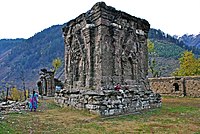Temple de Kali à Kalat
| Type |
|---|
| Localisation |
|---|
| Coordonnées |
|---|
Le temple de Kali à Kalat (en brahoui/ourdou : کالی مندر قلات ; translittération : Kali Mandir) est un temple hindou situé à Kalat, dans la province du Baloutchistan, au Pakistan. Il est dédié à la déesse hindoue Kali[1].
Histoire[modifier | modifier le code]
La ville de Kalat compte 2 % d'Hindous[2]. Plusieurs marchands hindkowans (en) hindous se sont installés dans la ville[3],[4].
Le temple se trouve en bas de la citadelle de l'État princier de Kalat. Il date de l'époque pré-islamique en Asie du Sud.
« [Le temple] était autrefois connu sous les noms de Kalat-i-Seva (du nom d'un roi légendaire hindou) et Kalat-i Nicari, qui le relie à la tribu baloutche brahouiophone des Nicari, généralement considérée comme la branche la plus ancienne des Brahouis indigènes[5]. »
La ville de Kalat aurait été nommée Qalat-e Sewa (« la forteresse de Sewa »), d'après Sewa, un héros légendaire baloutche local.
Notes et références[modifier | modifier le code]
- (en) Cet article est partiellement ou en totalité issu de l’article de Wikipédia en anglais intitulé « Kalat Kali Temple » (voir la liste des auteurs).
- Daily Times article on Varun Dev Temple
- (en) Encyclopædia Britannica : a new survey of universal knowledge, Volume 3, Encyclopœdia Britannica, (lire en ligne)
« Almost all the people are Muslim ; the largest Hindu minorities are in the Sibi (9%) and Kalat (2%) districts. »
- (en) Viking fund publications in anthropology, Issue 43, Viking Fund, (lire en ligne)
« ...is in the hands of a small caste of Hindu merchants. These Hindus are Hindko-speaking and regard Kalat as their homeland, where they generally keep their families and go for some months every year to visit and to obtain supplies. While in the Marri area, they must be under the protection of a local Marri chief or the sardar himself. »
- (en) The social organization of the Marri Baluch, Indus Publications, (lire en ligne)
« ...is in the hands of a small caste of Hindu merchants. These Hindus are Hindko-speaking and regard Kalat as their homeland, where they generally keep their families and go for some months every year to visit and to obtain supplies. While in the Marri area, they must be under the protection of a local Marri chief or the sardar himself. »
- (en) Martijn Theodoor Houtsma, E.J. Brill's First Encyclopaedia of Islam, vol. 4, 1913-1936, p. 678.



